A year in the life of Ray Smith and his friends, their center of life is the American west coast, this immensely cultured little town “which is called San Francisco”https://www.sueddeutsche.de/kultur/.”The Dharma Hunters” came out in 1958 , a year after “On the Road”, the book that made Jack Kerouac world famous, which created the myth of the Beat Generation, their alternative poets and bohemians.
The pathos of the great awakening is also present in this book, the excitement of being on the move, all the long highway drives and poetry readings in packed pubs, the dialectics of loneliness and community, of the desire to live in absolute freedom and weariness in the face of the narrowness of the bourgeois middle class – but all of this is cushioned here in an existentialist context, through Buddhist ideas of all kinds, which are practically implemented for an alternative way of life. An artistic-intellectual Buddhism that, when it encounters the vastness of the American landscape, remains incredibly casual and playful (which the original title “The Dharma Bums” sums up nicely, in German it sounds too goal-oriented).
Behind the narrator Ray Smith is Kerouac himself, this time single is on the road, for days, across the country, as a hobo on freight trains or hitchhiking, taken along by long-distance drivers or lone travelers. It is an adventure book of its own kind, retrograde and circular in its movements, in keeping with the nature of Buddhism – the goal matters little, more the stopping points, the stations that you make, nights in the great outdoors, meditation, ecstasy, stillness and cold. A “modern metaphysics of movement”. the writer Matthias Nawrat mentioned in his afterword to a new translation published for Kerouac’s centenary.
“…just a great new hero of American culture, wow!”
It begins on the west coast in late September 1955, Ray hops on a freight train in Los Angeles, spends the night in Santa Barbara, on the beach, the next morning it’s on to San Francisco, on the Ghost Train. He will later spend the Christmas season at his parents’ house in North Carolina with his mother. At night he retreats to the snow under a fir tree and meditates – the American myth of freedom and individuality.
Japhy Ryder, with whom Ray teams up in San Francisco (and behind whom is the Zen poet Gary Snyder), also has a mythical effect. A boy from a log cabin in Oregon, an outdoorsman and a mountain man, an eccentric compared to stuffy, career-minded Americans. He promotes the simple life, the boys cook and eat together, get liter bottles of wine as they please, buy clothes in second-hand or army shops. American experience of nature and Far Eastern philosophy go together in Japhy. “All of his education, Eastern wisdom, Pound, peyote experiences and visions, mountaineering and monastic wanderings aside – all of that aside, Japhy Ryder is just a great new hero in American culture, wow!”
One of the first nights there is the famous reading at the Six Gallery in San Francisco, where, among other things, the great piece of Beat Poetry “Howl” by Allen Ginsberg is presented – the book says “Wail” and the author is Alvah Goldbrook. Shortly thereafter, Japhy takes Ray up the Matterhorn, not the European peak, but the Matterhorn Peak in California. A self-awareness trip. “When you get to the top of a mountain,” is one of Buddhism’s beautiful paradoxical sayings, “keep climbing.”
Jack Kerouac: The Dharma Hunters. Novel. Translated from the English by Thomas Überhoff. With an afterword by Matthias Nawrat. Rowohlt 2022. 287 pages, 24 euros.
The book is peppered with such sentences that play into the absurd and are therefore so practical. This is the program of the Dharma Bums – contradiction, provocation, non-conformity. The something did not come into being out of the nothing, but the nothing out of the something. Behind the visible world there is only great emptiness: “How terrible if the world were real, for then it would be immortal.” Cheerfully zapping between the various Buddhist teachings, from the Ryoanji rock garden to samadhi ecstasy, chattering is turned into a naïve art. The yabyum (which they do in the temples of Tibet) is an erotic game, man and woman intertwined, and when Japhy explains this to Ray, using the “Om mani padme hum”, it sounds like old-fashioned student slapstick and solves it too Kerouac fans unease today – the male thunderbolt poking into the female dark void.
Ray’s story ends in the summer of 1956, taking a summer job that Japhy told him about, the ultimate experience of a Dharma Bum: a few months on an isolated fire station lookout on Desolation Peak in Washington, on the Canadian border. Two months of emptiness and nothingness, absolute solitude above the clouds, exposed to the storms and the rain. The mountain guide who takes Ray up, his name is Happy, speaks from experience of being on this mountain, from Dharma boom to Dharma boom: “Everyone starts talking like heroes. But at some point you start talking to yourself. And that’s not so bad as long as you don’t get yourself too answerYoung.”

